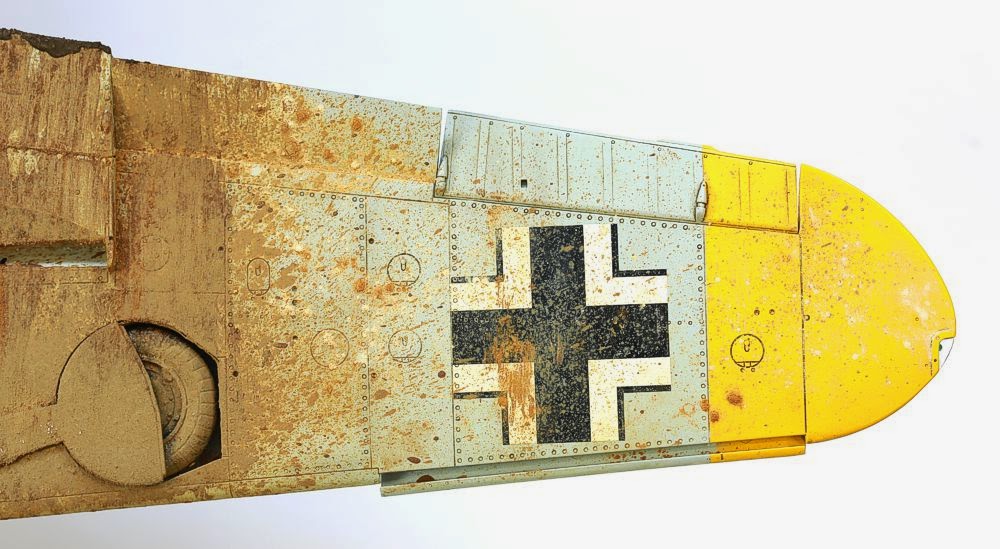Foreword
After
a break of almost 5 years from plastic scale modeling, I came across
the Hasegawa
1/32nd scale kit of the Messerschmitt
Bf 109 G-6 (Gustav) in
my stash of unbuilt kits. Going through the Kagero
#22 book on the Bf109G, I found two black and white photographs of a
crash landed Gustav
coded black 13
wearing white winter camouflage.
Two
photographs of the authentic situation depict the following setting:
Black 13 of 9./JG 51 crash landed in January 1944 either
due to a mechanical problem or enemy gun fire (although no signs of
this are recognizable in the photographs) on an initially
snow-covered and harvested cornfield. Black 13 remained in this
situation for some time before being finally recovered. Most of the
snow had melted away in the meantime leaving only some residues of
snow and slush underneath the right wing. The ground was frozen at
the time of the crash landing as the aircraft did not dig in very
deep into the frozen ground. Damage to the aircraft seemed to be
limited; the rearward bent propeller blades indicate that the engine
was running at the time of impact with the ground and the oil spill
on the spinner, upper propeller blade and on the engine cowling
seemed to originate from the ruptured oil tank directly behind the
spinner. The left landing gear dropped out of its bay due to a loss
of hydraulic pressure.
The
aircraft in white winter camouflage with lightish dried mud stains on
the dark, wet cornfield presents an attractive contrast and setting
for a diorama.
Construction
Construction
of the kit was straightforward. The kit has no fit issues and
represents a fairly accurate reproduction of the famous Bf109
fighter. Nonetheless, I decided to use a resin cockpit set from Aires
as I will leave the canopy open which allows a good view into the
pilot´s compartment. On the authentic photographs, one can see the
storage compartment hatch open, too.
The
Hasegawa
kit is lacking in rivet detail and I opted to use a stone beading
tool to emboss the countersunk-head rivets using the Kagero
drawings and photographs as a reference.
Some snap shots:
 |
|
01
Internal
detail of the storage compartment
consists of a horizontal floor and
a vertical
bulkhead at the rear end of the compartment. These
parts
were made of sheet styrene. The longitudinal
stringers were made of
u-shaped brass profiles.
The compartment was painted with Tamiya
AS-12,
followed by a coat of hairspray. The compartment
was then
airbrushed RLM 02 grau
(grey). The
weathering consists of chipping, scuffs and
scratches and
a final oil wash of raw umber.
|
 |
|
02 I
embossed the rivets along panel lines freehand
with a stone beading
tool and used strips of thick
tape as a guide when embossing rivet
lines
across panels.
|
 |
|
03 The
fuselage and all lower surfaces were
airbrushed in RLM 76 and
all upper surfaces in
RLM 75. Since the white winter camouflage
was
quite dense on black 13, I just airbrushed one
upper surface
color.
|
 |
|
04
With
the camouflage colors dry, I airbrushed
the white winter camouflage
in three layers:
(i) vertical streaks on the fuselage and streaks
parallel to the airflow on all horizontal surfaces,
(ii) a cloudy
mottling on all surfaces and finally
(iii) a layer of heavily thinned
white lacquer to
blend all layers together.
|
 |
05
I
designed both styles of the »13« on the
computer and made some test
printings on paper
to finally adjust the design. Next, I cut masks
from Kabuki tape of both »13« and attached
them to the fuselage and
applied a
thin coat of black lacquer by airbrush.
Once the paint was
dry I removed the masks.
|






































